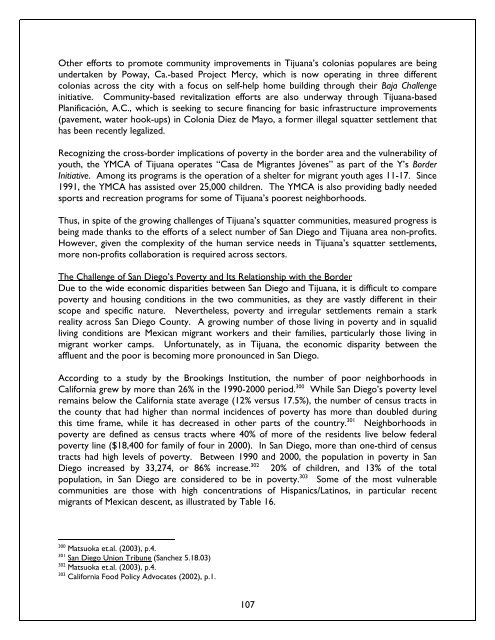Blurred Borders - International Community Foundation
Blurred Borders - International Community Foundation
Blurred Borders - International Community Foundation
Create successful ePaper yourself
Turn your PDF publications into a flip-book with our unique Google optimized e-Paper software.
Other efforts to promote community improvements in Tijuana’s colonias populares are being<br />
undertaken by Poway, Ca.-based Project Mercy, which is now operating in three different<br />
colonias across the city with a focus on self-help home building through their Baja Challenge<br />
initiative. <strong>Community</strong>-based revitalization efforts are also underway through Tijuana-based<br />
Planificación, A.C., which is seeking to secure financing for basic infrastructure improvements<br />
(pavement, water hook-ups) in Colonia Diez de Mayo, a former illegal squatter settlement that<br />
has been recently legalized.<br />
Recognizing the cross-border implications of poverty in the border area and the vulnerability of<br />
youth, the YMCA of Tijuana operates “Casa de Migrantes Jóvenes” as part of the Y’s Border<br />
Initiative. Among its programs is the operation of a shelter for migrant youth ages 11-17. Since<br />
1991, the YMCA has assisted over 25,000 children. The YMCA is also providing badly needed<br />
sports and recreation programs for some of Tijuana’s poorest neighborhoods.<br />
Thus, in spite of the growing challenges of Tijuana’s squatter communities, measured progress is<br />
being made thanks to the efforts of a select number of San Diego and Tijuana area non-profits.<br />
However, given the complexity of the human service needs in Tijuana’s squatter settlements,<br />
more non-profits collaboration is required across sectors.<br />
The Challenge of San Diego’s Poverty and Its Relationship with the Border<br />
Due to the wide economic disparities between San Diego and Tijuana, it is difficult to compare<br />
poverty and housing conditions in the two communities, as they are vastly different in their<br />
scope and specific nature. Nevertheless, poverty and irregular settlements remain a stark<br />
reality across San Diego County. A growing number of those living in poverty and in squalid<br />
living conditions are Mexican migrant workers and their families, particularly those living in<br />
migrant worker camps. Unfortunately, as in Tijuana, the economic disparity between the<br />
affluent and the poor is becoming more pronounced in San Diego.<br />
According to a study by the Brookings Institution, the number of poor neighborhoods in<br />
California grew by more than 26% in the 1990-2000 period. 300 While San Diego’s poverty level<br />
remains below the California state average (12% versus 17.5%), the number of census tracts in<br />
the county that had higher than normal incidences of poverty has more than doubled during<br />
this time frame, while it has decreased in other parts of the country. 301 Neighborhoods in<br />
poverty are defined as census tracts where 40% of more of the residents live below federal<br />
poverty line ($18,400 for family of four in 2000). In San Diego, more than one-third of census<br />
tracts had high levels of poverty. Between 1990 and 2000, the population in poverty in San<br />
Diego increased by 33,274, or 86% increase. 302 20% of children, and 13% of the total<br />
population, in San Diego are considered to be in poverty. 303 Some of the most vulnerable<br />
communities are those with high concentrations of Hispanics/Latinos, in particular recent<br />
migrants of Mexican descent, as illustrated by Table 16.<br />
300 Matsuoka et.al. (2003), p.4.<br />
301 San Diego Union Tribune (Sanchez 5.18.03)<br />
302 Matsuoka et.al. (2003), p.4.<br />
303 California Food Policy Advocates (2002), p.1.<br />
107















